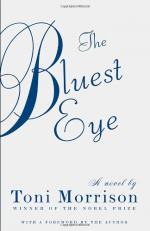|
This section contains 6,944 words (approx. 24 pages at 300 words per page) |

|
SOURCE: Fick, Thomas H. “Toni Morrison's “Allegory of the Cave”: Movies, Consumption, and Platonic Realism in The Bluest Eye.” Journal of the Midwest Modern Language Association 22, no. 1 (spring 1989): 10-22.
In the following essay, Fick analyzes the themes, structures and characters of The Bluest Eye in relation to Western literary and philosophical traditions, as primarily represented in T. S. Eliot's The Wasteland and Plato's “Allegory of the Cave,” and their significance to African American economic and social conditions.
Toni Morrison's first novel, The Bluest Eye (1970), is an unusually effective exploration of racism in twentieth-century American in part because of the place it gives to central legacies of Western civilization. Like Ralph Ellison, whose Invisible Man draws on Emerson and Whitman as well as folklore, Morrison recognizes the importance of Western literature and philosophy to the Afro-American experience in America; in some ways The Bluest Eye stands opposed to more...
|
This section contains 6,944 words (approx. 24 pages at 300 words per page) |

|


